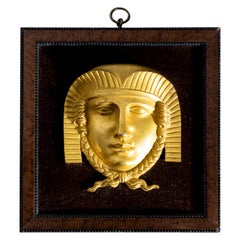Empire Sphinx Maskaron
Recent Sales
Antique Early 19th Century French Empire Busts
Bronze
A Close Look at empire Furniture
From 1804–15, Napoléon I reigned as the emperor of France, bringing the country into a new era of opulence after the fall of the monarchy and the tumultuous years of the French Revolution. He declared, “We must have very solid things, made to last 100 years.” Empire-style furniture followed suit, with imposing pieces constructed from mahogany and adorned with gilded ornaments. Expanding on the neoclassicism popularized in the previous century — such as in Louis XVI style — Empire style borrowed from the great civilizations of antiquity, from Egypt to Greece and Rome, to connect this nascent empire to the power of the past.
Napoléon I believed the production of fine furniture would reflect the stature of the republic, with his official architects Charles Percier and Pierre-François-Léonard Fontaine leading the way with their work on his residences.
Luxurious materials, symmetrical shapes and bold colors characterize antique Empire-style bedroom furniture, armchairs, cabinets and other structures, with frequent motifs including mythological creatures, geometric designs, acanthus leaves, eagles, bees (the imperial emblem) and swans, a favorite of Empress Joséphine.
Flat surfaces, like marble tabletops, were accented with decadent details, such as the bronze furniture mounts made by sculptor Pierre-Philippe Thomire for the French palaces. Martin-Guillaume Biennais, who worked as the imperial goldsmith, crafted intricate luxury objects that mixed wood, fine metal, mother-of-pearl and ivory. Ormolu — or elaborate bronze gilding — was essential to French design in the 18th and 19th centuries as a cornerstone of the neoclassical and Empire styles.
The style became popular abroad, influencing the American Empire style. Stately pieces carved with sprigs of olives by cabinetmaker Pierre-Antoine Bellange were acquired by American President James Monroe for the White House in 1817.
Find a collection of antique Empire tables, lighting, seating and other furniture on 1stDibs.
Finding the Right busts for You
The presence of vintage and antique bust sculptures can add a necessary decorative layer to any interior. And just because a statue looks classical doesn't mean it has to be conventional.
A touch of whimsy, a dose of drama — a single bust can alter a room. And when placed in just the right spot, these statues can almost feel alive.
“They give humanity in a way that a more abstract sculpture can’t give,” says Los Angeles designer Timothy Corrigan, who loves pieces that beg to be touched. For a welcoming entry hall project in California, Corrigan selected an antique Persian rug and a bust that invites you to touch it. A collection of sculptures in wood, marble and brass complement the star of the show.
For Consort cofounder and creative director Mat Sanders, a bust doesn’t have to be pretty. “I most enjoy busts that are a little busted,” Sanders jokes — but choose something with a soul you can live with, as “sculpture representative of the human form carries with it an energy you will add to the space.”
The antique and vintage bust sculptures for sale on 1stDibs include Art Deco busts, mid-century modern busts and more.
